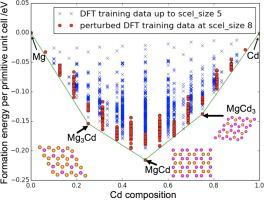当前位置:
X-MOL 学术
›
Comp. Mater. Sci.
›
论文详情
Our official English website, www.x-mol.net, welcomes your
feedback! (Note: you will need to create a separate account there.)
Effects of cluster expansion on the locations of phase transition boundary as a first step to quantify uncertainty in first principles statistical mechanics framework
Computational Materials Science ( IF 3.1 ) Pub Date : 2021-01-01 , DOI: 10.1016/j.commatsci.2020.110050 Liang Tian , Wenbo Yu
Computational Materials Science ( IF 3.1 ) Pub Date : 2021-01-01 , DOI: 10.1016/j.commatsci.2020.110050 Liang Tian , Wenbo Yu

|
Abstract Predicting phase diagrams from first principle calculations eliminates the need of tedious experimental trials and errors. Fully automating first principle phase diagram calculations without any sort of human intervention has been a long daunting task and troubling scientific communities for decades. This grand problem remains not fully resolved, largely due to the vastly high-dimensional parameter space associated with density functional theory, cluster expansion, lattice Monte Carlo, and the substantial uncertainty propagating through a set of complex simulations. As a first step to tackle this grand problem, we reported a first demonstration of how sensitive phase boundary locations can be to various cluster expansion fittings and input DFT training data. To the best knowledge of the authors, this study reported the first ever attempt to quantify uncertainty in first principles statistical mechanics framework. In addition, a semi-automated phase transition detection algorithm has been devised in this paper to deal with the associated statistical errors and uncertainties from Monte Carlo method and its predecessor DFT calculations and cluster expansions. This algorithm has been applied in a classical cluster expansion Mg-Cd binary alloy system to detect phase transitions at various locations of phase diagram using different cluster expansions to demonstrate its predictive power and quantify uncertainties. The results suggested that using Chebyshev basis function shifted the transition locations toward the dilute solid solution phase and expanded the phase stability of concentrated ordered phases to wider composition range. The addition of perturbed defect configurations into training data set lowered the order-disorder transition temperature to be away from true transition temperature, suggesting the transition nature is indeed configurational disorder dominated rather than defect assisted. We found that the weighting has negligible effect on the transition locations, except for the case of using Chebyshev basis function to fit all non-weighted configurations that can be susceptible to Monte Carlo sampling hysteresis.
中文翻译:

聚类扩展对相变边界位置的影响作为量化第一原理统计力学框架中不确定性的第一步
摘要 从第一性原理计算预测相图消除了繁琐的实验试验和错误的需要。几十年来,在没有任何人工干预的情况下完全自动化第一原理相图计算一直是一项艰巨的任务,并困扰着科学界。这个大问题仍未完全解决,主要是由于与密度泛函理论、集群扩展、格子蒙特卡罗相关的大量高维参数空间,以及通过一组复杂模拟传播的大量不确定性。作为解决这个大问题的第一步,我们首次展示了相边界位置对各种集群扩展拟合和输入 DFT 训练数据的敏感程度。据作者所知,这项研究报告了首次尝试量化第一原理统计力学框架中的不确定性。此外,本文设计了一种半自动相变检测算法来处理蒙特卡罗方法及其前身 DFT 计算和集群扩展的相关统计误差和不确定性。该算法已应用于经典的簇扩展 Mg-Cd 二元合金系统,以使用不同的簇扩展来检测相图不同位置的相变,以证明其预测能力和量化不确定性。结果表明,使用切比雪夫基函数将转变位置向稀固溶体相转移,并将浓有序相的相稳定性扩大到更宽的组成范围。将扰动缺陷配置添加到训练数据集中降低了有序 - 无序转变温度,使其远离真正的转变温度,表明转变性质确实是配置无序主导而不是缺陷辅助。我们发现加权对转换位置的影响可以忽略不计,除了使用切比雪夫基函数来拟合所有可能受蒙特卡罗采样滞后影响的非加权配置的情况。
更新日期:2021-01-01
中文翻译:

聚类扩展对相变边界位置的影响作为量化第一原理统计力学框架中不确定性的第一步
摘要 从第一性原理计算预测相图消除了繁琐的实验试验和错误的需要。几十年来,在没有任何人工干预的情况下完全自动化第一原理相图计算一直是一项艰巨的任务,并困扰着科学界。这个大问题仍未完全解决,主要是由于与密度泛函理论、集群扩展、格子蒙特卡罗相关的大量高维参数空间,以及通过一组复杂模拟传播的大量不确定性。作为解决这个大问题的第一步,我们首次展示了相边界位置对各种集群扩展拟合和输入 DFT 训练数据的敏感程度。据作者所知,这项研究报告了首次尝试量化第一原理统计力学框架中的不确定性。此外,本文设计了一种半自动相变检测算法来处理蒙特卡罗方法及其前身 DFT 计算和集群扩展的相关统计误差和不确定性。该算法已应用于经典的簇扩展 Mg-Cd 二元合金系统,以使用不同的簇扩展来检测相图不同位置的相变,以证明其预测能力和量化不确定性。结果表明,使用切比雪夫基函数将转变位置向稀固溶体相转移,并将浓有序相的相稳定性扩大到更宽的组成范围。将扰动缺陷配置添加到训练数据集中降低了有序 - 无序转变温度,使其远离真正的转变温度,表明转变性质确实是配置无序主导而不是缺陷辅助。我们发现加权对转换位置的影响可以忽略不计,除了使用切比雪夫基函数来拟合所有可能受蒙特卡罗采样滞后影响的非加权配置的情况。











































 京公网安备 11010802027423号
京公网安备 11010802027423号